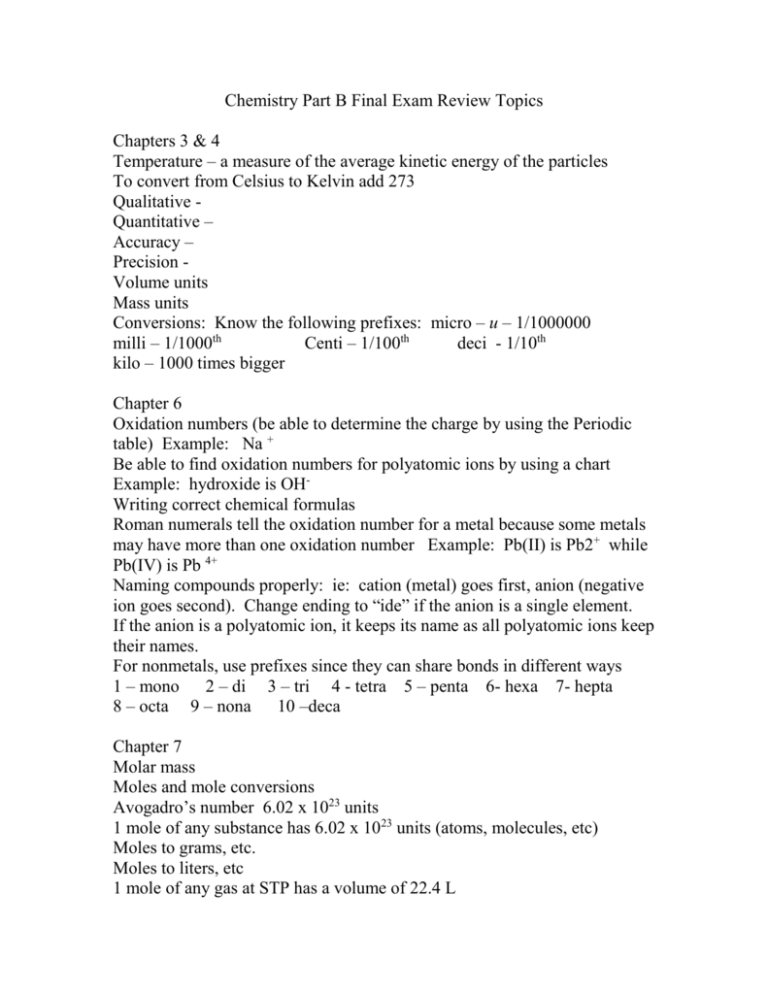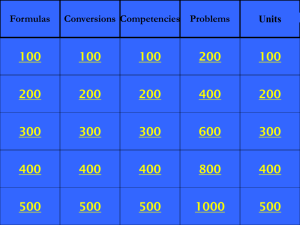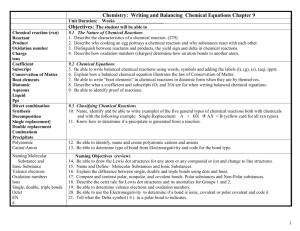Academic Chemistry Trimester 2 Final Exam Review
advertisement

Chemistry Part B Final Exam Review Topics Chapters 3 & 4 Temperature – a measure of the average kinetic energy of the particles To convert from Celsius to Kelvin add 273 Qualitative Quantitative – Accuracy – Precision Volume units Mass units Conversions: Know the following prefixes: micro – u – 1/1000000 milli – 1/1000th Centi – 1/100th deci - 1/10th kilo – 1000 times bigger Chapter 6 Oxidation numbers (be able to determine the charge by using the Periodic table) Example: Na + Be able to find oxidation numbers for polyatomic ions by using a chart Example: hydroxide is OHWriting correct chemical formulas Roman numerals tell the oxidation number for a metal because some metals may have more than one oxidation number Example: Pb(II) is Pb2+ while Pb(IV) is Pb 4+ Naming compounds properly: ie: cation (metal) goes first, anion (negative ion goes second). Change ending to “ide” if the anion is a single element. If the anion is a polyatomic ion, it keeps its name as all polyatomic ions keep their names. For nonmetals, use prefixes since they can share bonds in different ways 1 – mono 2 – di 3 – tri 4 - tetra 5 – penta 6- hexa 7- hepta 8 – octa 9 – nona 10 –deca Chapter 7 Molar mass Moles and mole conversions Avogadro’s number 6.02 x 1023 units 1 mole of any substance has 6.02 x 1023 units (atoms, molecules, etc) Moles to grams, etc. Moles to liters, etc 1 mole of any gas at STP has a volume of 22.4 L Molarity is all about the concentration of a solution A 1M solution of HCl has one mole of HCl (36.5 grams) dissolved in 1 Liter solution of water. A 2 M solution has 2 moles per liter of solution, etc. 500 mL of a 1M solution of HCl would have ½ of 36.5 grams (18.25 g) of solute because 500 mL is ½ L. % Composition – be able to calculate Chapter 8 Reactants Products Skeleton equations – writing them properly Balancing chemical equations by using coefficients 5 Types of chemical reactions (be able to recognize them when looking at a chemical equation) Chapter 15 Ion Ionic bonds Melting and boiling points are higher in ionic compounds compared with molecular compounds Know the difference between a formula unit (has ionic bonds) and a molecular compound (has covalent bonds and lower melting points) Chapter 16 Covalent bonds Single vs. double vs. triple bond Lewis dot structures for molecules Electronegativity – Polar bonds and nonpolar bonds Table of electronegativity and bond types on page 462 will help Polar molecules and nonpolar molecules Intermolecular forces: London dispersion forces, dipole – dipole, Hydrogen bonds (strongest) Acids have hydrogen in them. Example: HCl dissolved in water is hydrochloric acid. Diatomic molecule - Example: Cl2





